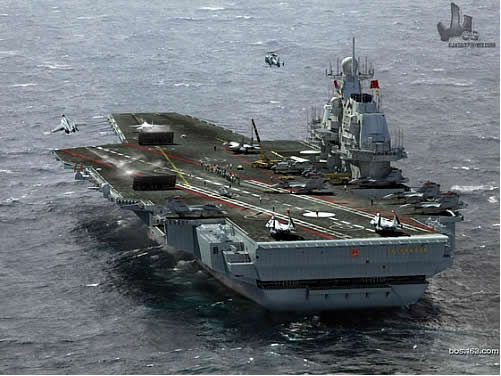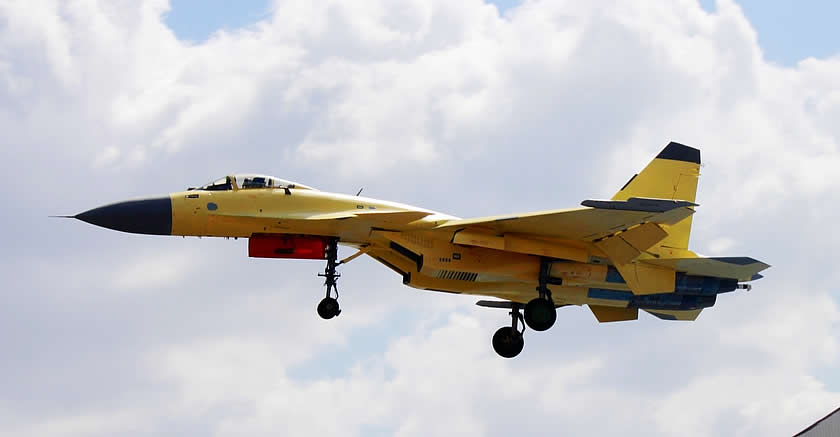Shi Lang Headed For Service
 April 29, 2011: All indicators are that the new Chinese aircraft carrier, the Shi Lang (formerly Varyag) will go to sea before the end of the year, after nearly nine years of reconstruction and upgrades. Defensive weapons, and more electronics, are being installed now, and major internal work appears to have been completed. snip The Shi Lang/Varyag is one of the Kuznetsov class carriers that Russia began building in the 1980s. - snip - The 323 meter (thousand foot) long ship normally carries a dozen navalized Su-27s (called Su-33s), 14 Ka-27PL anti-submarine helicopters, two electronic warfare helicopters and two search and rescue helicopters. But the ship was meant to regularly carry 36 Su-33s and sixteen helicopters. The ship carries 2,500 tons of aviation fuel, allowing it to generate 500-1,000 aircraft and helicopter sorties. Crew size is 2,500 (or 3,000 with a full aircraft load.) Only two ships of this class exist; the original Kuznetsov, which is in Russian service, and the Varyag.
April 29, 2011: All indicators are that the new Chinese aircraft carrier, the Shi Lang (formerly Varyag) will go to sea before the end of the year, after nearly nine years of reconstruction and upgrades. Defensive weapons, and more electronics, are being installed now, and major internal work appears to have been completed. snip The Shi Lang/Varyag is one of the Kuznetsov class carriers that Russia began building in the 1980s. - snip - The 323 meter (thousand foot) long ship normally carries a dozen navalized Su-27s (called Su-33s), 14 Ka-27PL anti-submarine helicopters, two electronic warfare helicopters and two search and rescue helicopters. But the ship was meant to regularly carry 36 Su-33s and sixteen helicopters. The ship carries 2,500 tons of aviation fuel, allowing it to generate 500-1,000 aircraft and helicopter sorties. Crew size is 2,500 (or 3,000 with a full aircraft load.) Only two ships of this class exist; the original Kuznetsov, which is in Russian service, and the Varyag.While this carrier is not of the same class as the American Attack Carriers it will outclass every other navy in the West Pacific, and with first class aircraft could give the US Navy a good fight, especially a task force that was not covered by carriers or land based aircraft. It is certainly a sign of a navy that is growing in from costal defense force to contesting for Admiral Mahan’s control of the seas.
Of course Aircraft Carriers need aircraft.
Chinese Carrier Fighter Shows Its Colors
 April 28, 2011: New photos of the Chinese naval fighter, the navalized version of the J-11 (an illegal clone of the Russian Su-27), have appeared. This one is painted in Chinese Navy colors, and appears to be equipped with Chinese made electronics. This all grew out of China obtaining one of the Russian navalized Su-27s (the Su-33) from Ukraine, and taking tech (like the folding wings and beefed up landing gear) from it to navalize their 30 ton J-11 as the J-11BH (formerly the J-15). - snip - The Shi Lang is expected to serve as a training carrier, to prepare naval aviators for service on the two new carriers under construction.
April 28, 2011: New photos of the Chinese naval fighter, the navalized version of the J-11 (an illegal clone of the Russian Su-27), have appeared. This one is painted in Chinese Navy colors, and appears to be equipped with Chinese made electronics. This all grew out of China obtaining one of the Russian navalized Su-27s (the Su-33) from Ukraine, and taking tech (like the folding wings and beefed up landing gear) from it to navalize their 30 ton J-11 as the J-11BH (formerly the J-15). - snip - The Shi Lang is expected to serve as a training carrier, to prepare naval aviators for service on the two new carriers under construction.Depending on electronics this is probally not be in the same league as the Navy’s current F-18 and definitely not up to the F-22/F-35 class, but shows that in the relatively near future the Chinese will be building top class military aircraft. The F-22 and F-35 are now the goal for designers to meet and beat, in time the Chinese will have planes that can outdo even the F-18 and compete with the F-22/F-35.
The Second Artillery Corps Versus the USN
April 27, 2011: The Chinese Second Artillery Corps, spread over several provinces, has been expanding over the last few years. This includes adding two brigades apparently armed with the long rumored Chinese anti-ship ballistic missile, the DF-21D. This gives the Second Artillery Corps ten DF-21 brigades, plus brigades with several other types of missiles. snip The DF-21D is mainly intended for use against the USN (U.S. Navy), particularly the aircraft carriers. - snip - While the 500-2,000 kg (.5-2 ton) warhead usually contains a nuclear weapon, it is believed that China also has a conventional warhead. - snip - For example, two years ago, China launched another "remote sensing" satellite, joining two others in a similar orbit. These three birds are moving in formation, at an altitude of 600 kilometers, across the Pacific. Equipped with either radar (SAR, or synthetic aperture radar) or digital cameras, these three birds can scan the ocean for ships, even though the Chinese say their purpose is purely scientific. A typical SAR can produce photo quality images at different resolutions. At medium resolution (3 meters) the radar covers an area 40x40 kilometers. Low resolution (20 meters) covers 100x100 kilometers. This three satellite Chinese posse looks suspiciously like a military ocean surveillance system. This is the missing link for the rumored Chinese ballistic missile system for attacking American aircraft carriers.
Since the end of WWII, coast artillery has not been a concern of the US defense planning, after all there was no navy or combination of navies that could get past the US fleet. In the old communist block that was not the case, defending against the US Navy was a serious problem. The anti-shipping missile that is pretty much ubiquitous now, was first a Russian coast defense weapon. Working with Chinese Navy this modern Coast Artillry could force the US Navy to stand off a good distance from the Chinese coast hampering any effort to support the Philippines, Taiwan, Korea, or Japan.
Analysis
Whe viewing Chinese defense efforts we should not take a solely Amercentic view point. Look at the problem for the Chinese view.
- For decades the Chinese military was hobbled by political direction that was time locked in Mao’s long march. In the last twenty to thirty years China has made a number of improvements that could be described simply as building a self-respecting 21st century force.
- Every country on it’s border is potentially hostile, or a buffer between it and a potentially hostile country. This creates a requirment for a defense force of healthy quality and size.
- With the expansion of it’s industry it is importing a massive amount of oil from the Middle East. The protection of the vital shipping route seems to be a focus of Chinese naval policy. In addition to passing near poteintialy unstable or hostile countries in South East Asia it must cross the Indian
Of course, even though weapons developed for one purpose does not mean they can’t be used for another, the military situation in the Western Pacific is changing.
While much of the US defense and intelligence diplomatic interest thought and planning is bogged down in the sands of the Middle East and worried about new and improved counter insurgency warfare, this appears to be “preparing for the last war.” There are more serious problems that can not be forgotten about.
The days when when the High seas were an Amercan Lake are vanishing. A lot of people in Washington in both parties need to wake up.
See also:
How Not to Fix the Military
Book Review: Echof Battle
